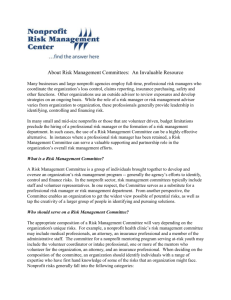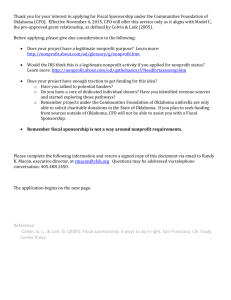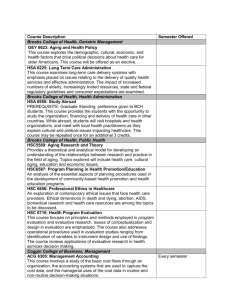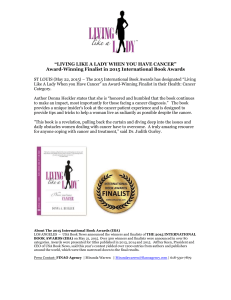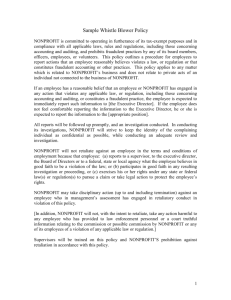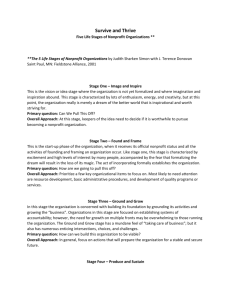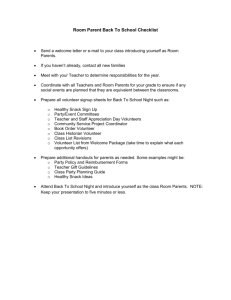Ifetayo Cultural Arts - Nonprofit Coordinating Committee of New York
advertisement
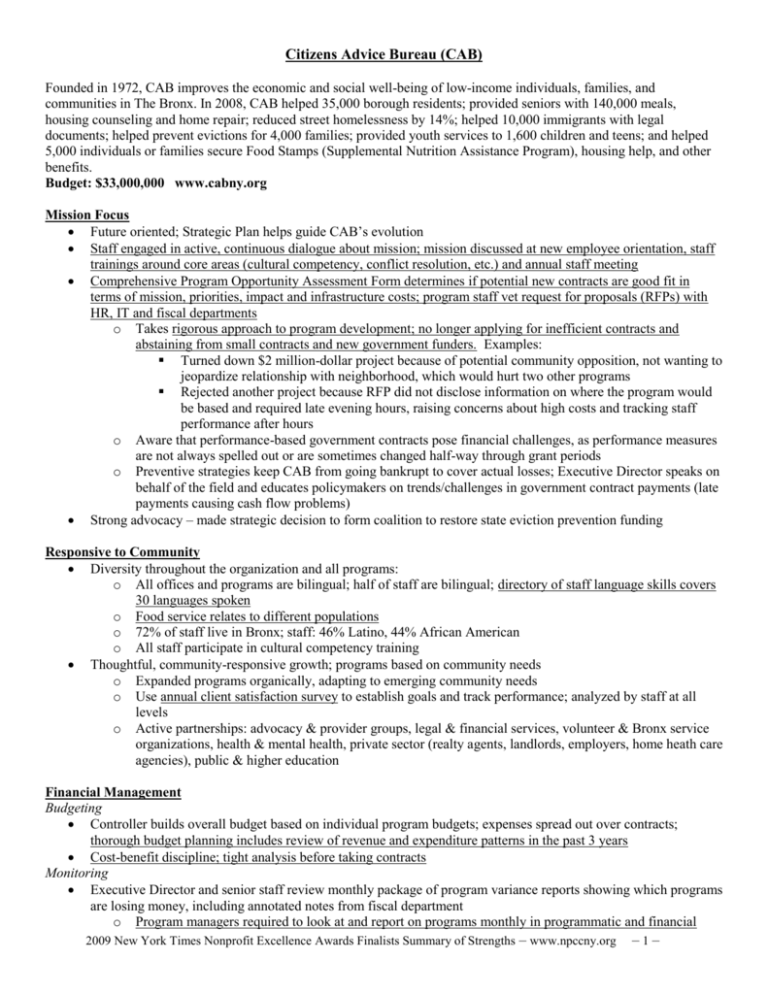
Citizens Advice Bureau (CAB) Founded in 1972, CAB improves the economic and social well-being of low-income individuals, families, and communities in The Bronx. In 2008, CAB helped 35,000 borough residents; provided seniors with 140,000 meals, housing counseling and home repair; reduced street homelessness by 14%; helped 10,000 immigrants with legal documents; helped prevent evictions for 4,000 families; provided youth services to 1,600 children and teens; and helped 5,000 individuals or families secure Food Stamps (Supplemental Nutrition Assistance Program), housing help, and other benefits. Budget: $33,000,000 www.cabny.org Mission Focus Future oriented; Strategic Plan helps guide CAB’s evolution Staff engaged in active, continuous dialogue about mission; mission discussed at new employee orientation, staff trainings around core areas (cultural competency, conflict resolution, etc.) and annual staff meeting Comprehensive Program Opportunity Assessment Form determines if potential new contracts are good fit in terms of mission, priorities, impact and infrastructure costs; program staff vet request for proposals (RFPs) with HR, IT and fiscal departments o Takes rigorous approach to program development; no longer applying for inefficient contracts and abstaining from small contracts and new government funders. Examples: Turned down $2 million-dollar project because of potential community opposition, not wanting to jeopardize relationship with neighborhood, which would hurt two other programs Rejected another project because RFP did not disclose information on where the program would be based and required late evening hours, raising concerns about high costs and tracking staff performance after hours o Aware that performance-based government contracts pose financial challenges, as performance measures are not always spelled out or are sometimes changed half-way through grant periods o Preventive strategies keep CAB from going bankrupt to cover actual losses; Executive Director speaks on behalf of the field and educates policymakers on trends/challenges in government contract payments (late payments causing cash flow problems) Strong advocacy – made strategic decision to form coalition to restore state eviction prevention funding Responsive to Community Diversity throughout the organization and all programs: o All offices and programs are bilingual; half of staff are bilingual; directory of staff language skills covers 30 languages spoken o Food service relates to different populations o 72% of staff live in Bronx; staff: 46% Latino, 44% African American o All staff participate in cultural competency training Thoughtful, community-responsive growth; programs based on community needs o Expanded programs organically, adapting to emerging community needs o Use annual client satisfaction survey to establish goals and track performance; analyzed by staff at all levels o Active partnerships: advocacy & provider groups, legal & financial services, volunteer & Bronx service organizations, health & mental health, private sector (realty agents, landlords, employers, home heath care agencies), public & higher education Financial Management Budgeting Controller builds overall budget based on individual program budgets; expenses spread out over contracts; thorough budget planning includes review of revenue and expenditure patterns in the past 3 years Cost-benefit discipline; tight analysis before taking contracts Monitoring Executive Director and senior staff review monthly package of program variance reports showing which programs are losing money, including annotated notes from fiscal department o Program managers required to look at and report on programs monthly in programmatic and financial 2009 New York Times Nonprofit Excellence Awards Finalists Summary of Strengths — www.npccny.org —1— terms (e.g. goals, targets, what they accomplished, variances) Fiscal department works with programs to track monthly billing, collections, expenses (e.g. number of pending/denied Medicaid claims and collections) Audit Committee meets (without staff) with Auditor; agency invests in management infrastructure by hiring key administrative staff such as an internal auditor, who makes recommendations on internal policies Board Finance Committee meets quarterly to review overall financial statements, then reports to full Board In relation to the current economic climate Conservative investments prevented significant losses compared to similar organizations Created contingency budgets with 5% and 10% cuts Aware that youth and shelter programs will be cut, whereas certain programs, like immigration programs, will be okay Other Adding outcome measures for non-performance based services Consistent excess of revenue over expenses every year Solid line of credit; only used during summer to cover delays in government contracts Governance Strong assessment process: o Individual Board performance criteria and assessment guidelines are in writing, given out at annual meeting; reports let Board members see aggregated data compared to their own individual performance (financial contributions and attendance) o Successful transition from board of local community members to a strong board with diverse skill sets that understands the nonprofit sector; each Board member serves on at least one committee o Board led strategic plan implementation committee Active Board: involved in reviewing program cost and performance; works closely with other staff (controller, auditor, etc.); members accompany Executive Director on visits to prospective or current donors; meets annually with insurance broker and pension carrier; finance committee Board periodically seeks feedback from external sources (Nonprofit Finance Fund analysis) Focus on Results Developed sophisticated tools for performance tracking: o Track individual worker productively monthly; goals set for all staff, from maintenance to program staff o Monitors homeless street outreach through GPS tracking; separated functions of outreach workers and case managers in order to more effectively meet the needs of long-term homeless individuals o Program Opportunity Assessment Form (described above) o Monthly Program Outcomes report with narrative for Executive Director o Comprehensive quarterly & monthly fiscal reporting, program area profitability analysis; monthly performance and fee-based program projection reports, program loss business plan Documents larger strategic outcomes linked to their programming (e.g., drop in homelessness) After incorporating better fiscal tracking, recognized patterns in government payments (lost money due to delays, city was not paying CAB correctly while CAB was fully reimbursing contractors); instituted corrective action plans as a result Other Analyze Program Opportunity Assessment Form to assess whether organization made good decisions regarding which request for proposals they responded to Strong Human Resources management: diverse staff has high level of understanding of mission/organization’s goals; solid staff appraisal process; Executive Director orients all new staff members; strong staff development, whistleblower and safety policies; conduct annual staff survey to identify and address staff concerns Successful major capital project for new administrative headquarters Greening initiatives 2009 New York Times Nonprofit Excellence Awards Finalists Summary of Strengths — www.npccny.org —2— Groundwork, Inc. Groundwork supports young people living in high poverty urban communities as they develop their strengths, skills, talents and competencies through effective experiential learning and work programs. It offers programs targeting children of all ages, including academic enrichment, tutoring, high school and college preparation, pregnancy and STD prevention, mentoring, leadership programs, employment, afterschool activities, athletics, literacy programs, and field trips. Groundwork also helps build strong families through individual, family and group counseling, peer groups, play therapy, and crisis intervention as well as meeting legal, financial and other needs. It has experienced rapid growth over the past 7 years, going from serving 89 students in 2002 to serving 3,500 families in 2009. Budget: $5.8million www.groundworkinc.org Mission Focused Human Resources Management/Staff Development Strategic plan outlines how the organization’s theory of change is tied to specific organizational outcomes and identifies infrastructures (e.g., staff roles) and management strategies needed to meet key organizational objectives Sophisticated employee evaluation process: o Involves staff from all levels o Performance reviews tailored to each position include broader “top-line” organization and program goals and outcomes o Corporate performance management model used as energizing force for keeping staff mission-focused and helps define expectations; also helps senior management identify emerging leaders and those who block organizational development o Each new staff person is fully oriented on the performance review process, whereby employees are assessed at the end of their first 90 days, every 6 months and through an annual review so that they are clear on what they are to achieve o All senior managers are required to participate in outside speaking engagements as part of the staff development and evaluation process Staff empowerment mechanisms: o Other staff empowerment opportunities include participation in board presentations, regular All Hands Staff Meetings, middle/senior management lunches, and invitations to speak on panels and attend conferences o Senior leaders are engaged in key strategic issues through weekly senior leadership meetings, regular attendance at board meetings, strategic planning, and analysis of funding opportunities o External training is provided for professional development o Cost-effective investments are made in identifying and sorting “growers” and “keepers;” developing skills of current staff to meet capacity gaps; Emerging Leaders group meets every four to six weeks, members discuss nonprofit management topics and get opportunities to work with the Board and on the strategic planning process o Following staff turnover, created “stretch assignments” and a “growth pipeline” to retain talented staff by providing them with more supervisory responsibilities o Accomplishments of staff are highlighted in e-newsletter, Blog, etc. Organization recognizes Human Resources challenges presented by rapid growth and its impact on staff availability to perform at higher levels; addressing these through site-based management teams and leadership development Communications Clear grasp of multiple constituencies with communication goals & strategies for 7 core groups: 1. Residents of catchment areas: comprehensive organizational brochure outlines all program offerings, applications, neighborhood events (health fairs, focus groups, etc.), flyers, parent orientations, community-driven website (Result: increased number of families served) 2. Current Employees: “All Hands” staff meeting, tight relationship between branding and development; new staff participate in Communications 101 session led by development and communications departments (review style guide, protocol for communicating with media, elevator pitch training and briefing on approved language), Intranet/Praxis bridges part-time and full-time staff; all materials are vetted by communications/development team, senior managers 2009 New York Times Nonprofit Excellence Awards Finalists Summary of Strengths — www.npccny.org —3— serve as “face” of the organization in order to broaden overall public perception of organization as not just the founder (Result: Increased engagement of organization with community and growing ability to articulate Groundwork’s mission to the community and outside stakeholders) 3. Potential Employees: Effective job descriptions, press, website/e-newsletter, formal group interview process, focus on Groundwork’s Employee Value Proposition (Result: Groundwork is able to attract high level employees with a commitment to social change) 4. Board of Directors: Quarterly review, event materials, Executive Director’s report (compilation of weekly program reports), development report (Result: Board more engaged and feels prepared to discuss Groundwork in a fundraising context) 5. School Principals: Organization brochure, neighborhood events, school based events, flyers, parent orientations, evaluation materials (Result: Principals are true partners and assist Groundwork in recruiting families, engaging classroom teachers and gathering evaluation data) 6. Nonprofit community: Participation on panels, press, website/e-newsletter, regular meetings to discuss best practices, coalition involvement, senior managers lead significant partnership development (Result: Groundwork is seen as a high performing youth development agency that maintains high quality partnerships) 7. Funding community: High quality funding proposals, continuous outreach, senior managers participate in site visits, press, evaluation materials, donor-driven website/e-newsletter (Result: Income has increased on a yearly basis) Tools include: monthly e-newsletter with mission driven content, intranet for greater communication between part-time and full-time staff, weekly blogs updated minimum of twice per week, Facebook & Twitter for young professional events and newsletter releases, Flickr & YouTube for sharing Groundwork’s story visually, using filmed student performances, pictures from events, etc. Communications efforts have produced concrete results: increased number of people served, exceeded fundraising targets, secured support from foundations, and maintained visibility with elected officials Outcomes Measurement Built infrastructure focused on metrics; hired Director of Evaluation in year two When setting program goals, began with bottoms-up conversation, asking staff: (1) What do you want for your clients? (2) What are the barriers? and (3) What “stools” do you need to get over those barriers?; process allowed for staff buy-in and was used to remind staff of the goals they agreed to work toward Monthly Institutional Report Card enables staff to quickly identify areas in need of improvement and make course corrections Quarterly Report on outcome goals vs. actual results shared at each board meeting and All Hands Staff meeting promotes further buy-in on outcomes; also demonstrates that all areas (governance, fiscal, development and human resources) are being evaluated, not just program (important for staff to know); also offers follow-up Q&A session to openly discuss challenges related to the report findings Outcome measurement tools, such as one for staff observation, enable organization to improve program performance and decide which programs to keep or eliminate Uses metrics that track individual and family participation across programs to strengthen retention and growth in the number of students served Other Board involvement: recruitment prospectus and site visits for all new Board candidates, Board report cards, each Board member suggests 25 names for end of year appeal, 100% Board giving Self-reflective Strong response to economic recession: sophisticated cost-cutting that preserves core services; bottoms-up contingency plans show worst case scenario budgets with bottom line savings and 12-14 month cash flow projections 2009 New York Times Nonprofit Excellence Awards Finalists Summary of Strengths — www.npccny.org —4— Legal Information for Families Today (LIFT) LIFT is a pioneer and leader in promoting access to justice for vulnerable families adrift in the New York City Family Court system without legal help. LIFT’s mission is to enhance access to justice for children and families by providing legal information, community education, and compassionate guidance, while promoting system-wide reform of the courts and public agencies. Budget: $1.9 million www.LIFTonline.org Cost-effective Strategies In 2003, started to focus on building capacity to strengthen outcomes measurement & innovation; intentionally built strong infrastructure by using free and low-cost resources Smart consumption of such free and low-cost resources ensures organization does not waste money on lesseffective services. Examples: o NYU Capstone & Rensselaerville Institute to create outcome measurement tools o Fund for the City of New York for programs database o Nonprofit Coordinating Committee for management workshops & member cost savings o Fiscal Management Associates to boost financial management, transparency & accountability o Taproot Foundation to create communications strategy, new logo, tagline and website o Support Center for Nonprofit Management for professional development o Stroock & Stroock & Lavan for general counsel, staff EEOC trainings, HR manual review, etc. o Volunteers to translate, provide frontline services, and administrative support o Consultants for one-time development needs and creation of outcome measurement tools, including new program-wide tool o Board of Directors for help with technology (intranet), real estate market analysis, etc. Focus on Results Program Planning o Program results are regularly achieved, tracked, evaluated, and reported in light of target goals and expected outcomes o Ground-up data collection and analysis: Monthly staff program trend reports presented to Executive Director; outcomes report presented quarterly to Board and at annual all-staff retreat Deputy Director manages outcomes measurement o Uses results to respond to emerging needs: increased web-based services after learning that an increased percentage of participants had internet access; uptick in requests for service led to creation of Relatives as Parents Program; data revealed mission drift at Brooklyn Criminal Court program Board & Management o Committees set annual goals which are monitored by Committee Chair and Executive Director o Board self-evaluation sets clear benchmarks that are tracked and reviewed annually; all exiting Board members participate in exit interviews o Staff performance reviews based on attainment of clearly articulated goals o Senior management holds a full-day annual goal setting retreat at the start of each Fiscal Year, followed by a full-day annual all-staff goal setting meeting; both meetings lead to creation of annual organizational goals; progress on these reported at ongoing staff and management meetings o Succession plans in place: Deputy Director prepared to take on role of Executive Director; Board Vice President to replace Chair; Board members encouraged to recommend own replacements Development & Finance o Annual development goals set in advance of Fiscal Year o Monthly development and finance reports presented alongside each other o Projections refined on monthly basis; Year-To-Date financial reports & cash flow projections carefully analyzed o Executive Director seeks feedback on rejected grant proposals; information is recorded and adjustments made o All funders receive complete program outcome reports 2009 New York Times Nonprofit Excellence Awards Finalists Summary of Strengths — www.npccny.org —5— Communications With help from the Taproot Foundation: o Conducted communications audit, including market assessment o Created annually updated communications plan – includes brand identity and coherent story, revised logo and tagline, revamped website (mission driven, goal aligned and includes translation tool), social networking, annual grassroots fundraising appeal, eblasts, scheduled reports to stakeholders Strong and transparent external communications; financial information posted on intranets and website; cost containment stakeholder memo made available to current and potential funders Equally strong internal communications; staff/Board intranets, staff newsletter highlights program “success stories” Responsive and inclusive communications: o Multilingual participant materials o Participant feedback used to adjust and align program with changes in community needs, which often reflect shifting cultural/population dynamics. Example: findings led to new signage/materials for Courtbased programs o Measures communications impact (tracks survey results, participant levels, inquiries, eblast statistics, website traffic) for various stakeholders o New (forthcoming) website is user friendly for each stakeholder group Financial Management Key financial milestones and targets are monitored and met Full Board trained by Fiscal Management Associates to read financials; proactively recruited members with financial expertise Clear process for creating and approving annual budget at the Board and management level: o Annual budget prepared by management in consultation with program directors, Board Treasurer and President. Board Audit/Finance Committee reviews the budget, then goes via email to full Board with management narrative; Board discusses and votes on budget at September Board meeting, ensuring budget is in place when fiscal year begins October 1. o 2009 budget included a fiscal contingency plan Financials presented to Board Audit/Finance Committee monthly and quarterly to full Board, but always available on Board/staff intranet. Financial package includes: Balance Sheet Grants Receivable Accounts Payable Budget Comparison (Year-To-Date) Report Components of Earned Revenues Statement of Cash Flows Cash Flow Projections In response to economic climate, increased reserve fund, decreased budget, forestalled office move, and implemented contingency plan for downsizing; also made changes in day-to-day operations by renegotiating contracts and lowering costs (using cheaper office supplies, etc.) Other Self-reflective/earnest pursuit of feedback, learns from mistakes and is consciously evolving Strong and growing governance; managed Board transition in smart, sophisticated way Strong use of volunteers 2009 New York Times Nonprofit Excellence Awards Finalists Summary of Strengths — www.npccny.org —6— Neighborhood Economic Development Advocacy Project (NEDAP) NEDAP promotes community economic justice and works to eliminate discriminatory economic practices that harm communities and perpetuate inequality and poverty. NEDAP believes that everyone has the right to live in a decent, safe, healthy and thriving community, and that access to fair and affordable financial services and credit is fundamental to equitable neighborhood development. NEDAP employs multiple strategies – community outreach and education, advocacy, coalition organizing, policy research and analysis, media outreach, technical support for community groups, and direct legal services – to promote neighborhood equity and address inequities in the financial services system that adversely affect people living in lower income neighborhoods and communities of color. Budget: $1,188,000 www.nedap.org Focus on Mission Achieves mission by (1) staying policy-driven, (2) not growing the organization for its own sake (avoids bureaucracy, only builds based on need), and (3) focusing on New York City communities despite being a local organization with both national and local impact; still able to achieve large scale impact with small staff Nimble (willingness to change program models) but true to mission; principle of developing resources cautiously and incrementally to avoid mission creep (does not accept money from banks to retain independence) Committed to sharing expertise/training with other organizations consistent with mission; acts as a resource center for small community based organizations; builds bridges between neighborhood groups and organizations Involves all staff to pursue mission and Board sees themselves as guardian of mission (staying true to policy-driven agenda) Response to Emerging Issues Identifies emerging issues and works with groups (organizations, coalitions, etc.) on the ground to effectively and ethically engage neighborhoods When emerging issues arise, engages staff across program areas in devising organizational response, which in turn helps develop internal expertise, build confidence and boost morale among staff At forefront in responding to one of the most devastating, emerging issues – the mortgage foreclosure crisis o Began in 1995 focusing on promoting community reinvestment and combating redlining; expanded scope to address other abusive and discriminatory financial practices, such as predatory mortgage lending o Helped form Center for NYC Neighborhoods in response to recent explosion in foreclosures in NYC, to coordinate comprehensive foreclosure prevention services citywide o Created NYC Foreclosure Prevention Gap Loan Fund after recognizing the need and receiving a $1 million anonymous donation o Launched Consumer Law Hotline after identifying urgent need for direct legal services for New Yorkers, on abusive consumer credit and debt collection practices—hotline has responded to thousands of calls from low income New Yorkers o Developed formal state-wide coalition—New Yorkers for Responsible Lending (links larger groups like AARP to smaller community-based organizations)—to fill state advocacy void; actions led to passage of 4 key state laws o Builds critical bridges between community groups and regulators/policy-makers to impact policy Communications Uses communications to pursue mission and educate communities and groups on emerging issues: o Collects and distills complex information in understandable, meaningful ways for policymakers, community groups, and the general public o While responding to rapidly-changing environment, combats misinformation and ensures that information it provides is locally relevant and accurate Focuses on electronic networking with constituents and collaborators, using multiple channels and adapting foci depending on media and constituency. Example: For the Obama Foreclosure Prevention Plan, creating: o Homeowner fact sheets o Media talking points & PSAs o Training material for community, counseling and legal service groups, attorneys, and judges Strong tracking and testing of communications: 2009 New York Times Nonprofit Excellence Awards Finalists Summary of Strengths — www.npccny.org —7— o Routine in-house focus groups, before releasing material, for all levels of constituents (lawyers, consumer advocates, neighborhood groups, individuals and families) o Automatic feedback loop from community-based organizations ensures quality control o With broad-based, external stakeholders, collects diverse feedback from constituents Acknowledges staff contributions through all organizational communication venues Extensive unpaid media coverage; talks to media (national and local) on a near-daily basis Created monthly television show, “On the Money with NEDAP,” to communicate information to New Yorkers Human Resources Management/Staff Development Shared executive leadership, with defined roles, allows for system of checks and balances Team-based staffing approach with junior staff engages them in decision making Invests in staff development, salaries and benefits for employees o 3-month paid staff sabbatical after 5 years o Priority on staff learning and training: learning allowance/account of $500 per staff, per year Annual offsite staff retreats include site visits to other groups doing similar work Financial Management Strong balance sheet Diverse funding Leverages resources to have high impact with relatively small budget Healthy reserve fund in place; well prepared to adapt to emergencies Cautious growth, fiscally responsible Instituted policy that all collected fees for service go into financial reserves Board approves each line item on budget and full Board votes on budget Thoughtful, mission-relevant investment policy: invests primarily in community development credit unions (Lower East Side People’s Federal Credit Union, Latino Community Credit Union) Has very small investments in 3 corporations through a donor’s shareholder investment (as way to engage in shareholder activism with these companies) In response to current economic climate, is focused on building individual donor database Focus on Results Impressive use of outcome tracking, especially given size and age of organization: provides various lenses to look at data and knows what data to track Tracking issues raised through Consumer Hotline led to policy change – saw that 68% of 1,800 new calls were related to frozen bank accounts and worked with lawmakers to close loophole At weekly intake meetings, and in collaboration with other groups, devised strategy to address need for financial education for immigrants after influx of calls regarding barriers faced by immigrants trying to open bank accounts post-9/11 & Patriot Act; convened vibrant coalition to launch financial education/advocacy campaigns Governance Intentional 7-member Board with no formal committees mirrors small, collaborative culture of organization Clear Board member expectations— 100% yearly giving; board members may not participate in meetings by conference call Board works to remind organization of bigger picture (focus on policy, 5-year strategic plan, vets new programs) Learning Organization Learning organization in the best sense: created management structure that enables learning (e.g., shared executive leadership); very reflective despite rapidly paced work environment (vertical examination, top to bottom and macro to micro) 2009 New York Times Nonprofit Excellence Awards Finalists Summary of Strengths — www.npccny.org —8— New York Cares New York Cares meets pressing community needs by mobilizing caring New Yorkers in volunteer service. Each year, New York Cares brings vital volunteer support to more than 990 nonprofit agencies, public schools, and other deserving organizations throughout the five boroughs. Program staff works with each organization to identify their most pressing needs, create projects where volunteers can make a meaningful difference, and then recruit and deploy teams of volunteers to help meet those needs. The great majority of these projects typically would not exist if it were not for New York Cares. Budget: $5.1 million www.nycares.org Financial Management Budgeting Strategic plan guides budgeting process Careful expense projections involve entire organization o Conduct bottom up analysis using matrix of each expense projection by department, produced by Program Managers, Directors and Senior Directors o Review year-on-year changes o Board Finance Committee reviews budget before June Board Meeting o All-staff review budget led by Executive Director before July 1 o Program expense snapshots (submitted by each Program Manager) include monthly expenses by location, # of total slots, # of participants, # of projects, and budget for each location as well as highlighted expansion scenarios demonstrating how the Program Managers “own the goals” Revenue projections o Acknowledge fundraising goals within the budget planning process o Monthly revenue projections for all staff; presented by category for individual and special events o Fulfill most challenge grants and also set campaign goals; development team secured 13 new corporate funders since January Monitoring Revenue Status Report keeps track of money in hand and receivables; distributed to key staff (Development, senior staff & interested program staff) weekly and includes pledges by each category (e.g. corporations, individuals, etc.) Monthly financial packet to Board Finance Committee includes: o Account Reconciliation o Balance Sheet and Statement of Activities o Review of progress against budget (e.g., directors review Profit & Loss) o Analysis of “real” shortfall or surplus vs. budget: on time, delayed, denied, or early status of each budgeted pledge o Thorough analysis of major expenses (vetted 7 vendors before selecting database provider) Full Board receives financial packet 1 week prior to Board meetings; detailed donor report shows donations that have been approved, denied and delayed Separate Board Audit Committee Forecasting Contingency planning o Month-by-month contingency triggers with percent projections enabled Board to make quick cuts without terminating employees; cuts are suggested by Program Managers Strong focus on cash liquidity o $3mm cash in hand with average expenses of $460k per month; Monthly Board Finance Committee works with senior staff to develop 3-year outlook based on changes in revenues and expenses; organization proactively thinks about what it wants/needs to do in terms of programming and decides how different scenarios will affect the organization’s liquidity When funding goals are exceeded, Board encourages staff to further advance strategic plan Communications Communications department “acts like its own agency,” and is integrated into program and development departments; consumes 5% of overall expenses while bringing in contributed services equaling 20 times the value 2009 New York Times Nonprofit Excellence Awards Finalists Summary of Strengths — www.npccny.org —9— of investment; no advertising budget, yet capitalizes on pro-bono advertising (in-kind donations from media partners & buyers valued at $4.9 million) Annual Communications Plan rolled into overall Strategic Plan with goals and metrics for each level (volunteers, donors, annual events, special events, branding and other stakeholders); includes communications calendar and involves internal and external planning process Uses electronic media thoroughly to reach volunteer and general audiences: email by constituency; social media for building community; microsites (e.g. Serve-a-thon fundraising); database that uses real-time data and integrates into workflow; website (98% of volunteers communicate by the website) Strong Brand Management o Very strong staff awareness/understanding of organizational positioning and messaging o Recognized need to adjust brand promotion when it was discovered that the annual Coat Drive was seen as the brand o After pro-bono brand review, created benchmarks, new logo, and tagline; instituted more sample success stories around volunteering Tracks fundraising and volunteer recruitment related to PR coverage, advertising and website usage Uses special “Moves Management” process to communicate with individual donors Internal communications are open, transparent and consistent: formal training process for new staff; regular board and staff meetings; annual Vital Statistics document, a collection of program accomplishments and organizational statistics shared with staff and Board to ensure consistent communication with external audiences; talking points developed for all major events; coaching/training for spokespeople; new interdepartmental PR workgroup Human Resources Management (Includes Volunteers) Internal cross fertilization around functions at all levels of the organization fosters succession at the project leadership, staff and board level Leverages Board in smart ways for results: individual meetings with President and each Board member on goal setting; uses “The Big C’s” policy which stands for Commitment, Connections, Creativity, Congeniality, Collaboration, Communication, and Compliance Solid focus on staff and volunteer development: performance-based promotions (promotes from within); ongoing cross-training activities; autonomy in middle management; improved comp policies to address unfair work demands (important to morale and retention); holds morale boosting activities; voted one of best places to work in NYC (Crain’s, Wall Street Journal & Princeton Review); Staff accountable for individual numerical targets Formalized diversity policy; grew % of people of color by 64% as staff grew by 50% Strategic, smart and successful volunteer management: Volunteer Engagement Scale tool tracks volunteer progress, helps staff refine volunteer leadership training, track volunteer peer referrals, track individual giving to volunteer engagement level and analyze staff time/expenses used at each engagement level to project effectiveness; tracks partner satisfaction; exceptional commitment to volunteer diversity (represent NYC’s ethnicity, geography and age); volunteers are managed as extension of staff (thoroughly trained, goals are outlined and then volunteer performance is evaluated against those goals) Other Results-based management: learns from and acts on data findings Strong use of technology for planning, outcomes monitoring, communications, and volunteer matching Case book example of integrating outcomes-based strategic plan: all management tools feed each other; Board and senior staff uses plan to review ongoing progress Disciplined approach to new program development: pilots new programs with organization’s own unrestricted funding before soliciting other kinds of support; fosters atmosphere of innovation in which only the most successful programs are expanded by seeking restricted funding 2009 New York Times Nonprofit Excellence Awards Finalists Summary of Strengths — www.npccny.org — 10 — Vera Institute of Justice The Vera Institute of Justice combines expertise in research, demonstration projects, and technical assistance to help leaders in government and civil society improve the systems people rely on for justice and safety. Vera is an independent, non-partisan, nonprofit center for justice policy and practice, with offices in New York City, Washington, DC, and New Orleans. Vera’s projects and reform initiatives, typically conducted in partnership with local, state, or national officials, are located across the United States and around the world. Budget: $19.5 million www.vera.org Financial Management Unusual degree of partnership between finance staff, program staff and Board: o Program & finance staff create reports based on program manager needs, creating shared fiduciary responsibilities and enabling buy-in and fiscal ownership by program staff; program staff also given support and training around project budgets; quarterly review and forecasting for each project allows for regular updating and adjustment o Staff produce fast and accurate data and offer wise, principled judgments to Board (staff produced financial crisis contingency plan for organization in four days); finance staff turn around reports for Board (Investment & Finance Committees) and staff within 48 hours; quick communications and working partnerships led to only 24% drop in endowment (better than most nonprofits during crisis) Healthy balance sheet Uses agency-wide real-time budgeting In response to financial crisis: o Devoted more attention to both revenue and expenses (program staff now more conscious); instituted furloughs and enrolled in the New York Department of Labor’s Shared Work Program to save money, limit layoffs, promote continuity, and offer staff with reduced hours an opportunity to get additional financial assistance o Slowed opening of an LA office, postponed a new project o Taking more conservative approach to managing endowment o Board working with staff to monitor budget; Finance Committee will receive real-time financial information on a monthly basis o More aggressively targeting new funders in new geographic areas, including new federal dollars; considering capital campaign (if economy recovers) Self-Assessment & Staff Learning Invests in staff by providing strong benefits, multi-level learning environment, and professional development Does not see money as barrier to educational opportunities: o Offers concrete internal learning opportunities for staff and Board (trainings, discussion groups, peer-topeer exchange, etc.) o Seeks out free and low-cost external training opportunities o Provides internal self-assessment mechanisms such as peer coaching, pre-mortems, post-mortems, client evaluations & feedback o Staff encouraged to learn new skills (e.g., public speaking, etc.) and to practice them in front of colleagues; then provided live feedback from peers as well as audio/video recordings Affiliate program leverages former employees and scholars to build expertise and new relationships Focused Growth Planning Implemented strategic plan in 2005 with new foci: strengthen work across three substantive areas, improve NYC and State level work, and expand nationally (New Orleans & Washington, DC) Strategic plan identified four main ways to promote clarity and consistency in Vera’s work: 1. Creating new internal structure to provide consistency (especially combining research and program staff) 2. Rethought how to deliver services outside New York Added new offices Built in cost-effective remote virtual offices with structured supervision 3. Use communications to promote clarity & consistency in Vera’s work Articulated mission/vision in first brochure 2009 New York Times Nonprofit Excellence Awards Finalists Summary of Strengths — www.npccny.org — 11 — Conscious rebranding process Outreach events Annual gala Annual Justice Address 4. Instituted feedback loop Include Board members on Advisory Committees Established an internal opportunity fund to incubate and develop new innovative projects Communications Sophisticated understanding of relationship between communications and program staff; identifies different audiences for each project and tracks monthly communications impact Very thorough and smart about policy communications: o Editorial expertise ensures sophisticated coverage and effective dissemination Targeted communications to reporters Washington office ensures publications reach policymakers and interest groups “Think-tank” quality to work makes sure policy briefs are digestible for all audiences o Proactive and careful response to dealing with sensitive press issues –the Board weighed the risks and benefits to Vera’s mission when deciding to take on one particular project, formed Advisory Committees to conduct independent study (Vera agreed only to participate as long as had full independence), planned pre-release & post-release publicity strategy (e.g., on context and nuance) and retained control by giving exclusive coverage to two newspapers Learning from Mistakes & Commitment to Field: When a project showed early negative results, convened a panel to identify why it did not work and published findings online for the field to learn from Failure helped organization become more cognizant Learned it is important to monitor projects in real-time (e.g., monthly financial variance reports; client feedback before, during and after); provide dashboards that show what to look for, what clients value, what do others want to see measured For spin-off projects, instituted written “Independence Agreements” that spell out specific benchmarks that new 501(c)(3)s are expected to accomplish Research staff performing work for program staff enter into streamlined agreements outlining project goals Very thoughtful spin-off strategy; created impressive spin-off toolkit for others to learn from: http://www.vera.org/content/vera-institute-justice-spin-tool-kit Board Involvement Solid program vetting (votes on every demonstration project) Impressive finance and management expertise (tight fiscal controls, monitoring of budget vs. actual) Right balance between senior management and Board (Board does not micro-manage) 2009 New York Times Nonprofit Excellence Awards Finalists Summary of Strengths — www.npccny.org — 12 —


